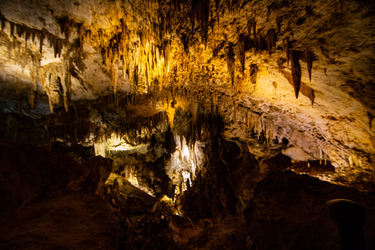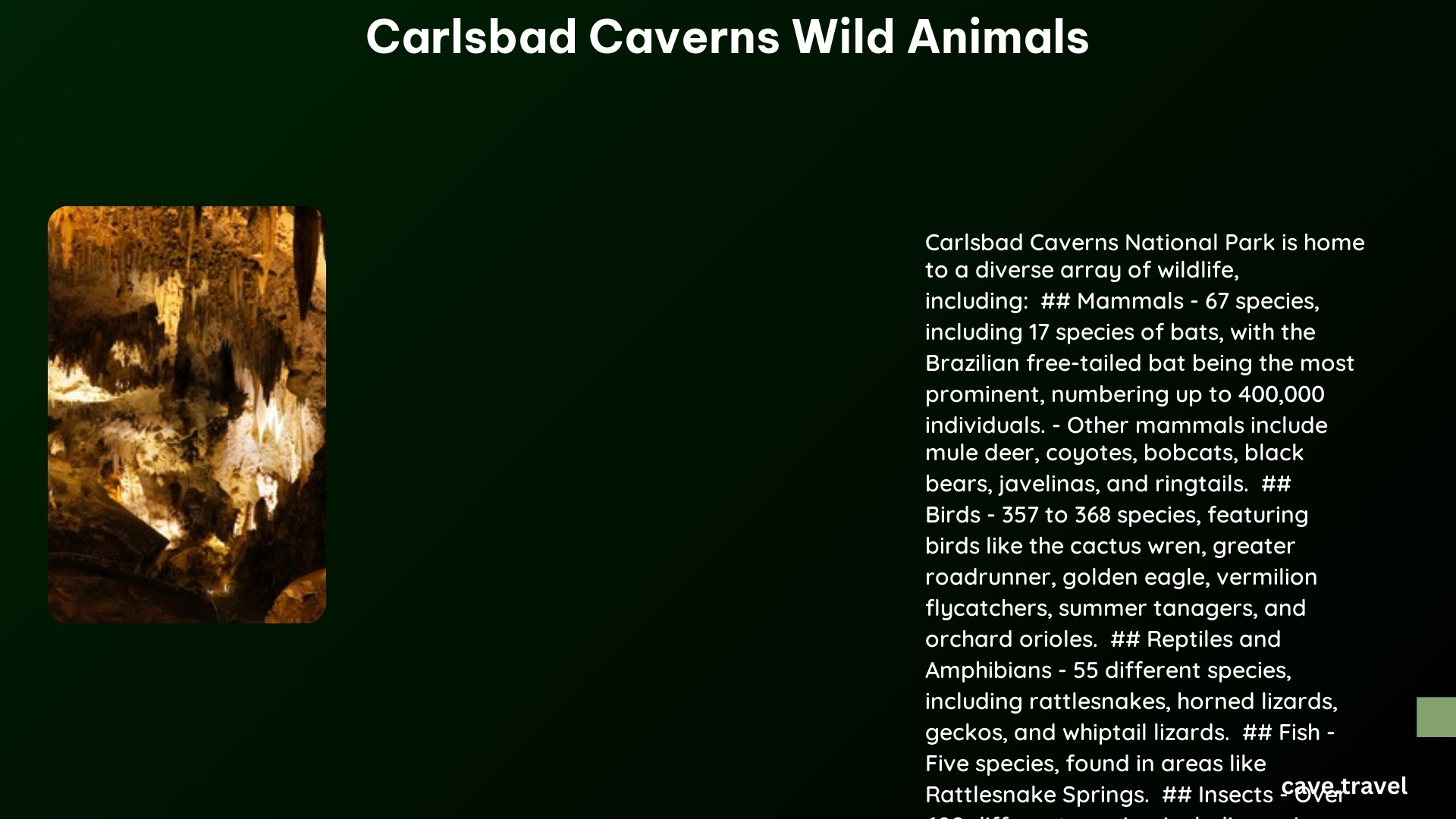Carlsbad Caverns National Park is a haven for wildlife, boasting an impressive array of species both above and below ground. The park’s unique ecosystem supports 17 bat species, 357 bird species, 55 reptiles and amphibians, and 67 mammal species. From the iconic Brazilian free-tailed bats to elusive ringtails, the park’s diverse habitats nurture a rich tapestry of wildlife, making it a prime destination for nature enthusiasts and researchers alike.
What Makes Carlsbad Caverns a Wildlife Hotspot?

Carlsbad Caverns National Park’s location at the intersection of three biogeographic provinces contributes to its exceptional biodiversity. The park encompasses various habitats, including:
- Desert scrub
- Piñon-juniper woodlands
- Grasslands
- Underground cave systems
This diverse landscape provides ideal conditions for a wide range of wildlife to thrive. The permanently flowing water at Rattlesnake Springs further enhances the park’s ecological diversity, attracting numerous species.
Which Bat Species Call Carlsbad Caverns Home?

Bats are undoubtedly the stars of Carlsbad Caverns. The park hosts 17 different bat species, with the Brazilian free-tailed bat (Tadarida brasiliensis) being the most prominent. Here’s a breakdown of some key bat species found in the caverns:
- Brazilian free-tailed bat
- Cave myotis
- Fringed myotis
- Townsend’s big-eared bat
- Mexican free-tailed bat
The Brazilian free-tailed bat colony is particularly impressive, with numbers reaching around 400,000 during peak summer months.
When and Where Can Visitors Observe Bat Flights?
Bat enthusiasts can witness spectacular bat flights at Carlsbad Caverns during specific times:
- Season: Late March to October
- Best months: August and September
- Time: Dusk (exact time varies by season)
- Location: Bat flight amphitheater near the natural entrance
During these flights, hundreds of thousands of bats emerge from the cave to hunt for insects, creating a mesmerizing natural spectacle.
What Other Mammals Inhabit the Park?
Beyond bats, Carlsbad Caverns National Park is home to a diverse array of mammals. Here’s a table showcasing some notable species:
| Species | Habitat | Behavior |
|---|---|---|
| Mule deer | Woodlands, grasslands | Crepuscular, browsers |
| Cougars | Various habitats | Solitary, nocturnal predators |
| Javelinas | Desert scrub | Nocturnal, omnivorous |
| Black bears | Woodlands | Omnivorous, semi-arboreal |
| Ringtails | Rocky areas, caves | Nocturnal, agile climbers |
These mammals contribute to the park’s complex ecosystem, each playing a unique role in the food web and habitat dynamics.
How Does the Park’s Avian Diversity Compare to Other Regions?
Carlsbad Caverns National Park boasts an impressive 357 bird species, making it a prime destination for birdwatchers. This diversity is particularly notable given the park’s location in a semi-arid region. Some standout species include:
- Vermilion flycatchers
- Summer tanagers
- Painted buntings
- Orchard orioles
Rattlesnake Springs, with its permanent water source, is an especially productive area for bird watching within the park.
What Reptiles and Amphibians Thrive in the Park’s Varied Habitats?
The park’s 55 species of reptiles and amphibians have adapted to its diverse environments. Notable species include:
- Texas horned lizards
- Black-tailed rattlesnakes
- Desert box turtles
- Couch’s spadefoot toads
- Various geckos and skinks
These cold-blooded creatures play crucial roles in the park’s ecosystem, serving as both predators and prey in the food web.
How Do Nocturnal Animals Contribute to the Park’s Ecosystem?
Many of Carlsbad Caverns’ animals are nocturnal, adapting to the harsh desert conditions by being active at night. This nocturnal activity contributes to the park’s ecosystem in several ways:
- Pollination of night-blooming plants
- Seed dispersal
- Pest control (especially by bats consuming insects)
- Maintaining predator-prey balance
Nocturnal species like ringtails, javelinas, and various bat species take advantage of cooler nighttime temperatures and reduced predation risks.
What Conservation Efforts Protect Carlsbad Caverns’ Wildlife?
The National Park Service implements various conservation strategies to protect the diverse wildlife of Carlsbad Caverns:
- Population monitoring: Regular surveys to track species numbers and distribution
- Habitat management: Maintaining and restoring natural habitats
- Visitor education: Programs to inform visitors about wildlife and conservation
- Research support: Collaborating with scientists to study park ecosystems
- Invasive species control: Efforts to manage non-native plants and animals
These efforts aim to preserve the park’s biodiversity for future generations while allowing visitors to experience its natural wonders.
How Does Climate Change Impact the Park’s Wildlife?
Climate change poses significant challenges to Carlsbad Caverns’ wildlife:
- Shifting temperature and precipitation patterns affect plant communities
- Changes in cave humidity and temperature impact bat populations
- Altered migration timing for birds and bats
- Increased frequency of extreme weather events stress wildlife populations
Park managers and researchers are closely monitoring these impacts and developing strategies to help wildlife adapt to changing conditions.
What Unique Adaptations Do Carlsbad Caverns’ Animals Exhibit?
The diverse wildlife of Carlsbad Caverns has evolved various adaptations to thrive in the park’s unique environments:
- Bats: Echolocation for navigation in dark caves
- Desert mammals: Water conservation mechanisms and nocturnal behavior
- Cave-dwelling invertebrates: Loss of pigmentation and eyes in some species
- Reptiles: Ability to thermoregulate in extreme temperature conditions
These adaptations showcase the remarkable resilience and diversity of life in Carlsbad Caverns National Park.
References:
– https://www.newmexicomagazine.org/blog/post/carlsbad-caverns-national-park-wildlife/
– https://www.nationalparkstraveler.org/park/subpage/wildlife-carlsbad-caverns
– https://www.nps.gov/cave/learn/nature/animals.htm
